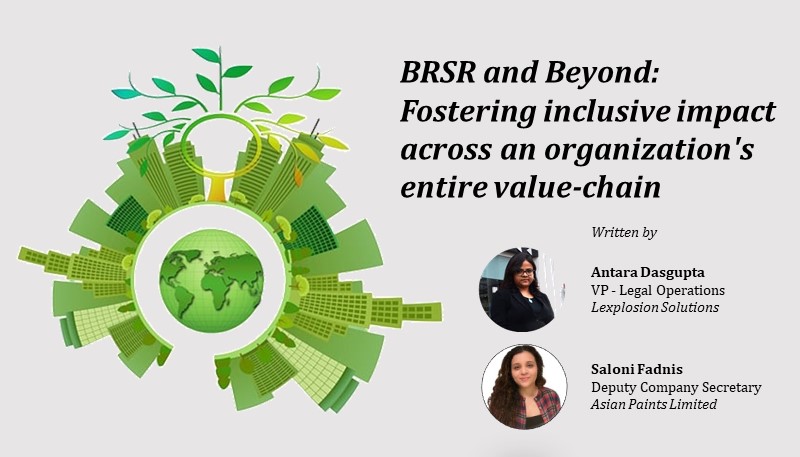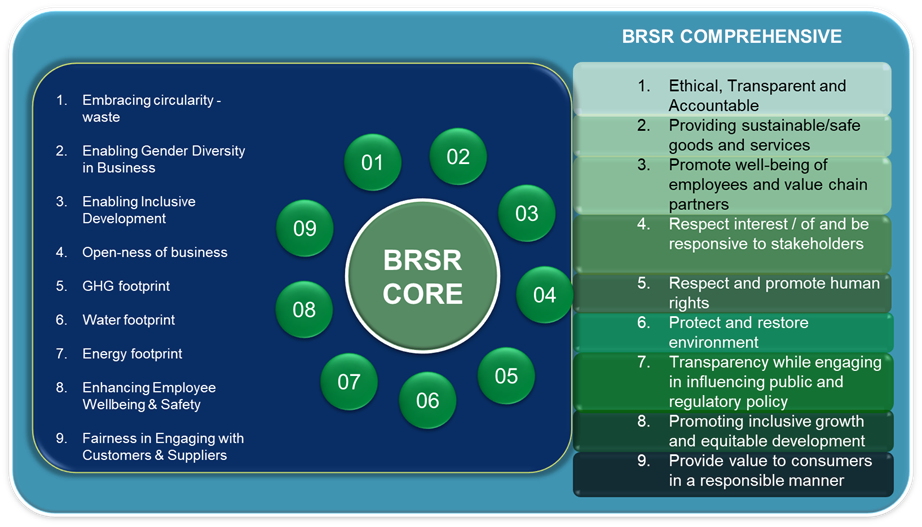BRSR and Beyond: Fostering inclusive impact across an organization’s entire value-chain

As India’s Top 150 listed companies (by market capitalization) are poised to file their first-ever ESG disclosures for its value-chain through BRSR Core in the Annual Report from FY 2023–24 onwards, let’s delve into the model of governance underpinning the Business Responsibility and Sustainability Reporting (BRSR). In all this while if you are of the view that BRSR holds significance only for the foremost listed companies, we would recommend you spare a few minutes reading this blog. Here, we have attempted to express that while the onus to report BRSR rests on the listed entity/ies, the thrust is on fostering environmental, sustainability and governance across its entire business value chain.
As evident, since the listed entities will be required to make disclosures and obtain assurance as per the BRSR Core for their value chain, they will have a fair amount of responsibility to collate the data, check its accuracy, validate it and confirm on its credibility as they will be making these disclosures in their Annual Report. Hence, we notice a fiduciary relation of sorts between the listed entity who is required to file the BRSR Report and its value chain partner to ensure the data is correct and accurate. Reporting on sustainability has its own challenges. It is not only expensive but needs a fair amount of investment to hire experts and professionals in getting the necessary data points in order.
As such it may not be commercially viable for a value chain partner to make the disclosures as desired by the regulator. By bringing the listed company in the picture it is expected that they will deeply engage, handhold and ensure the accuracy of the data of their value chain partners. There is a fair amount of preparation that will go into this process. A few suggestions from our end for listed companies who need to comply with BRSR Core towards preparing this data for their value chain partners would be to:
- List out the Value Chain Partners they work with
- Categorize them between Upstream and Downstream partners
- Select / Shortlist Top 75% by value (purchase/sales)
- Engage / Communicate
- Collect Data / Verify and consolidate data
- Report / Disclose in Report
Some of the challenges which can be anticipated here are that value chain partners may be MSMEs and may not be capturing this information all this while. Further, if the information is required as of 31st March and large companies have their Board Meetings in the last week of April and first week of May – will this information be available to be shared by MSMEs? If some information is linked to financial statements / requires audit or is Unpublished Price Sensitive Information (UPSI) for listed companies – how will it be shared?
It’s not only about the disclosures in BRSR Core which listed companies need to report out for its value chain, if we look at the updated BRSR format (Annexure II) which is the comprehensive report in which the Top 1000 listed entities (by market capitalization) will need to make its disclosures effective FY 2023 – 2024, again to be reported as a part of their Annual Report, you will notice a fair number of disclosures sought in this report are in respect of their value chain partners such as:
- Whether policies and processes set by listed companies extend to their value chain.
- Well-being measures implemented for the value chain partners,
- Assessment of value chain partners on health, safety practices and working conditions.
- Measures undertaken by the listed entity to guarantee that statutory dues have been appropriately deducted and deposited by their value chain partners.
- Assessment of value chain partners concerning issues such as sexual harassment, workplace discrimination, child labour, and forced labour etc.
- Significant adverse impact on the environment resulting from the value chain activities and outline measures taken to mitigate these impacts.
Acknowledging that the by virtue of the disclosures mandated in BRSR and BRSR Core there is a significant increase in the compliance burden, not only for listed companies but also their value chain partners. It is imperative for these value chain partners to align themselves with the sustainability policies of the respective companies that they are partnering with. This alignment is not only crucial for thriving in a conscientious business environment but will also ensure their continued relevance to the listed companies. Failing to do so may pose a tangible risk of losing business from these listed entities.
Regardless of the scale, whether you are a small enterprise or a corporate giant, integrating sustainability concerns into your compliance ecosystem is paramount. The quest to make profits should not be your sole concern; instead, equal emphasis should be placed on the responsibilities towards both people and the planet. This approach signifies a shift towards a more holistic and responsible business model, where considerations for environmental and social impacts are integral components of the overarching compliance framework.
The applicability of BRSR Core will go beyond the Top 150 listed entities in the years to come. The Securities and Exchange Board of India (SEBI) has specified a glide path as per which, effective FY 2024-25 the Top 250 listed companies are mandated to file BRSR Core, Next, FY 2025-2026 the Top 500 listed companies are mandated to file BRSR Core in the Annual Report and the Top 1000 will need to file the same effective FY 2026-27.
[box type=”bio”]
An organization’s Value Chain
An organization’s value chain includes entities with which the organization has a direct or indirect business relationship and which either supplies products or services that contribute to the organization’s own products or services or receives products or services from the organization. As far as reporting in BRSR Core is concerned, the value chain must encompass the listed company’s top upstream and downstream partners, cumulatively comprising 75% of its purchases / sales (by value) respectively.[/box]
[box type=”bio”]
What is BRSR Core?
BRSR Core is essentially a framework for assurance and ESG disclosures for a company’s value chain. The BRSR Core is a sub-set of the BRSR, consisting of a set of Key Performance Indicators (KPIs) / metrics under the 9 ESG attributes. Listed entities are required to report the KPIs in the BRSR Core for their value chain to the extent it is attributable to their business with that value chain partner. This reporting may be segregated for upstream and downstream partners or can be reported on an aggregate basis.[/box]

𝐖𝐚𝐧𝐭 𝐭𝐨 𝐝𝐞𝐞𝐩 𝐝𝐢𝐯𝐞 𝐟𝐮𝐫𝐭𝐡𝐞𝐫?
– 𝑪𝒉𝒆𝒄𝒌 𝒐𝒖𝒕 𝒐𝒖𝒓 𝒑𝒓𝒆𝒗𝒊𝒐𝒖𝒔 𝒃𝒍𝒐𝒈 𝒑𝒐𝒔𝒕 𝒐𝒏 𝑩𝑹𝑺𝑹: https://lexplosion.in/brsr-raises-the-bar-for-esg-disclosures-in-india/
– 𝑾𝒂𝒕𝒄𝒉 𝒐𝒖𝒓 𝒘𝒆𝒃𝒊𝒏𝒂𝒓 𝒐𝒏 𝑩𝒖𝒔𝒊𝒏𝒆𝒔𝒔 𝑹𝒆𝒔𝒑𝒐𝒏𝒔𝒊𝒃𝒊𝒍𝒊𝒕𝒚 𝒂𝒏𝒅 𝑺𝒖𝒔𝒕𝒂𝒊𝒏𝒂𝒃𝒊𝒍𝒊𝒕𝒚 𝑹𝒆𝒑𝒐𝒓𝒕𝒊𝒏𝒈: The Future of Environmental, Social and Governance Compliances in India: https://lexplosion.in/knowledge-centre/lexplosion-webinars/business-responsibility-and-sustainability-report-the-future-of-environmental-social-and-governance-compliances-in-india/
Written by: Antara Dasgupta
Co-authored by: Saloni Fadnis
Disclaimer
This content is intended for informational purposes only and does not constitute a legal opinion. Despite our efforts to maintain accuracy, we do not make representations, warranties or undertakings regarding the quality, completeness or reliability of the content. Readers are encouraged to seek legal counsel prior to acting upon any of the information provided herein. This content, including the design, text, graphics, their selection and arrangement, is Copyright 2024, Lexplosion Solutions Private Limited or its licensors. ALL RIGHTS RESERVED, and all moral rights are asserted and reserved.
For any clarifications, please reach out to us at 91-33-40618083 or inquiries@lexplosion.in. Refer to our privacy policy by clicking here.